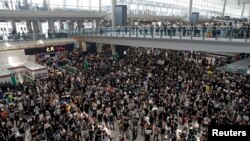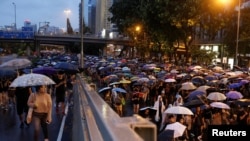On May 4, the Commissioner’s Office of the Chinese Foreign Ministry in the Hong Kong Special Administrative Region (HKSAR) issued a statement warning U.S. politicians not to “poke [their] nose at Hong Kong’s judiciary”:
“People will not forget that during the 2019 turbulence... external forces staged a Hong Kong version of ‘color revolution’ in an attempt to separate Hong Kong from the motherland again.”
That statement is false.
There is no evidence that external forces “staged” Hong Kong’s large pro-democracy movement in 2019.
Hong Kong is a former British colony that was returned to China in 1997. It was then promised a high degree of autonomy under a framework known as “One Country, Two Systems,” which is detailed in the 1985 Sino-British Joint Declaration, an international treaty still legally in effect.
Beijing promised Hong Kong it could preserve its judicial system, legislative and executive autonomy, civil society, freedom of speech, open internet and other key democratic features enjoyed by the people of Hong Kong at the time.
Within that context, Hong Kong’s mass protests in 2019 were a response to a bill proposed by Beijing that would have allowed Hong Kong to detain and transfer suspected criminals to China, Taiwan and Macau, with which Hong Kong has no formal extradition agreements.
Many feared the bill could undermine Hong Kong’s judicial independence. Critics worried that China would use it to punish political rivals, thus endangering dissidents who don’t share Beijing’s worldview.
This sparked mass protests, with hundreds of thousands of people taking to the streets and demanding the bill be withdrawn.
A series of Reuters-sponsored polls conducted by the Hong Kong Public Opinion Research Institute showed that at the end of 2019, 59% of Hong Kongers supported the anti-extradition bill protests, with over a third of the 1,021 respondents saying they had participated in the protest.
Reuters quoted Lingnan University political scientist Samson Yuen as saying the polls' results confirmed that the protesters’ key demands had broad public support in Hong Kong.
“[The polling results] also counter Beijing’s characterization of the protests as a movement aimed at undermining its sovereignty over the city,” Yuen said.
The extradition bill was finally withdrawn in September 2019, yet the anti-extradition movement had evolved into a much wider call for maintaining Hong Kong’s autonomy and democratic features that distinguish it from mainland China.
Governments around the world, including the U.S. and in Europe, supported the protesters’ right to exercise their freedom to rally peacefully and express their political demands. No governments or politicians in the West encouraged or supported the use of violence.
A color revolution aimed at regime change?
The term "color revolution" is used to describe popular, pro-democracy uprisings that have taken place around the world.
Examples include the “Bulldozer Revolution” in Serbia in 2000, the “Rose Revolution” in Georgia in 2003, the “Orange Revolution” in Ukraine in December 2004 and then the “Tulip Revolution” in Kyrgyzstan in early 2005. A few years later came the “Arab Spring” pro-democracy movement across the Middle East and North Africa.
According to a 2014 report by the Center for Strategic and International Studies, Russia largely sees these movement as “a new U.S. and European approach to warfare that focuses on creating destabilizing revolutions in other states as a means of serving their security interests at low cost and with minimal casualties.”
Beijing shares similar views. Chinese President Xi Jinping said last year at a summit of the Shanghai Cooperation Organization that China, Russia and Iran, among other countries, must work together to prevent “external forces” from promoting what he called “color revolution.”
So, what constitutes a color revolution?
Lincoln Mitchell, an expert on democracy and a former Columbia University faculty member, explained the three common color revolution criteria in his 2012 book, titled The Color Revolutions.
These revolutions usually result from questions raised about recent elections, have organized political leaders who play a major role, and occur in weak states.
None of these features apply to the anti-extradition movement in Hong Kong.
First, the movement’s initial goal was the withdrawal of the anti-extradition bill, and the protests were largely peaceful at this stage. Looting and destruction started later, when the government appeared unwilling to budge.
Second, the initial stage of the movement was not organized by opposition political leaders. The now disbanded Civil Human Rights Front (CHRF) organized two massive protests on June 9 and June 16, 2019.
VOA Mandarin Service reporter Paris Huang, who was on the scene at the start of the movement, reported that he did not see much coordination, saying “people were just coming out on their own...it’s all very organic.”
Thirdly, Hong Kong was not and is not a weak state. Per the Brookings Institution, a weak state typically has deteriorating physical infrastructure, neglected educational and health systems, falling GPD and other critical economic indicators.
None of that is true of Hong Kong. Life in Hong Kong is largely good: the city has a vibrant economy, a professional police force and an independent judicial system. Hong Kong’s GDP per capita in 2019 was $48,356, four times the amount that the World Bank commonly uses to rank countries as developed.






